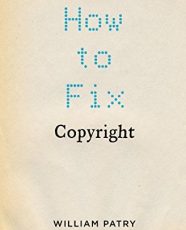Topical Highlight
A Copyright Reform Agenda from a Group of Like-Minded IP Teachers

Image from here
In this guest post, Prof. (Dr.) N.S. Gopalakrishnan provides us an overview of the recommendations focussing on desirable public interest oriented amendments to the Copyright Act prepared by a group of ‘like minded IP teachers’. He particularly summarises four broad themes of amendments. The first set of proposed changes deal with Section 52. These include an open-ended fair dealing clause under Section 52(1)(a), expanding educational use exception to cater to the needs of online learning, a specific exception for text and data mining, broader exceptions for libraries, etc., and broader exceptions to ensure access to the disabled. The next set of changes concern the definitions under Section 2. These include amendments to the definitions of ‘broadcast’ to clearly differentiate the rights of broadcasting organisations from that of the authors, ‘communication to the public’ to include live streaming, and ‘computer programs’ to exclude functional elements such as APIs. The third proposal is to exclude government works from copyright protection, and the final amendment proposed is to recognise international exhaustion in the area of copyright including digital exhaustion.
Thematic Highlight
Officer’s Choice v. Chetak Whisky: An Incorrect Choice of Jurisdiction?

Image from here
In this post, I analyse the issue of territorial jurisdiction that was dealt with by the Delhi High Court in a copyright and trademark infringement suit filed by Allied Blenders and Distillers Pvt Ltd for their ‘Officer’s Choice’ products. The court granted an ad interim relief holding that the objection of lack of territorial jurisdiction was not satisfied at this stage. I argue that the court reached at this conclusion by its failure to acknowledge the defendant’s arguments based on a seemingly incorrect interpretation, and relying solely on the averments in the plaint. I then discuss the two provisions based on which jurisdiction was claimed by the plaintiff. In the context of Section 20, CPC, I argue that the defendant could not be said to be carrying on business in Delhi as “the essential part” of the business did not take place there. Similarly, since there was no “imminent” or “real” threat of infringement in Delhi, cause of action could not have been said to arise there. Finally, the long-arm jurisdiction under the Trademarks Act or the Copyrights Act could not be invoked since the plaintiff had its subordinate office in Rajasthan where the cause of action arose.
Other Post
Section 46(2): ‘One Patent Per Invention’ or ‘One Invention Per Patent’?

Image from here
In this guest post, Mr. Amit Tailor analyses whether rejection of claim(s) of a later patent application having ‘similar’ or ‘overlapping’ scope with that of an ‘earlier’ patent application is appropriate under Section 46(2) of the Patents Act which provides that a patent can be granted for one invention only. He highlights that Section 46(2) is directed towards the concept of ‘unity of invention’ with discretion available to the Controller to grant a single patent for multiple inventions. He argues that instead the correct provision under which this challenge could have been brought is Section 13(1)(b) that deals with anticipation of the claim in a prior claim.
Decisions from Indian Courts
Other News from Around the Country
News from Around the World
For regular updates on IP news and opinions related to COVID-19, please visit our COVID-19 & IP Updates page (also accessible from the Resources section on our website).